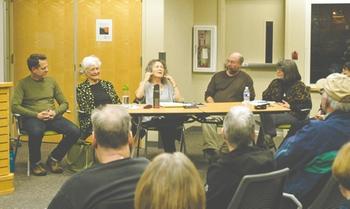Environmental activists opposed to Navy plans to conduct electromagnetic warfare training on the North Olympic Peninsula are working to bring attention to the project to the national stage.
“This is actually a national issue — an international issue,” Karen Sullivan, co-founder and spokesman of West Coast Action Alliance, said last week following the screening of a short film about the issue by Mitch Mattrow of Seattle.
The screening at the Port Angeles Library was viewed by an audience of about 40 people.
The untitled video can be viewed at http://tinyurl.com/PDN-ByAirLand-Sea.
Following the showing, Sullivan and other activists interviewed in the film took turns addressing the audience.
“This needs to become a national issue where all of us are speaking out on this with all of the voice that we can muster,” Sullivan said.
“Form a group, organize, make your voice heard, lend a hand.”
Special use permit
The Navy is seeking a special-use permit from the U.S. Forest Service to deploy — on 12 Olympic National Forest roads — three camper-size vehicles that would emit electromagnetic signals.
The trucks would engage in real-time exercises with radar-jamming jet pilots from Naval Air Station Whidbey Island.
The Navy’s environmental assessment of the project concluded the activity, which includes the emission of electromagnetic radiation, would not result in significant environmental impacts.
The roads lie below the Olympic Military Operations Area, an umbrella of naval air space that extends from Olympic National Park west to the coast and from the Strait of Juan de Fuca south to Grays Harbor County.
It includes portions of Clallam and Jefferson counties.
Greg Wahl, Olympic National Forest environmental coordinator, has said the agency will issue a draft decision on the permit this spring.
Spreading the word
Following last Thursday’s screening, Mattrow said he was inspired to help spread the word about the Navy’s plans after first learning of the project last summer.
Currently in Seattle, his hometown, very few know “about what is going on out here,” Mattrow said.
“I was called to action because I love the Olympic Park and the forest. I think they are sacred, and I’ve spent quite a bit of time out there.”
Something “had to be done,” he said, “so I went out there and spent a lot of time hiking and getting footage.”
“I think that we did some pretty decent work here to try and show what the plans are to essentially militarize the area,” he said.
“That is really what it boils down to. They are coming unless there is a collective opposition to stop it.”
National treasure
“We need to preserve this part of the world,” author Diana Somerville, who appeared in the film, said after the screening.
“To have Olympic National Park here is an amazing luxury. We are sitting on a treasure trove that the world has recognized . . . as an invaluable resource. To turn that into a militarization zone is a crime against humanity and the planet.”
Linda Weichman, a Lower Elwha Klallam artist who also appeared in the film, encourages the public to unite against the Navy’s plans.
“I really hope that we all come together and support” opposition groups “because it is all for all of us,” she said.
“We have to look at our future generations. We are here to heal the planet. We have to come together as one in order to save what is precious for us.”
Mattrow agreed, saying the Navy project would impact “multi-generations” to come.
Chris McDaniel is a reporter with the Olympic Peninsula News Group, which is composed of Sound Publishing newspapers Peninsula Daily News, Sequim Gazette and Forks Forum. Reach him at 360-452-2345, ext. 56650, or cmcdaniel@peninsuladailynews.com.



